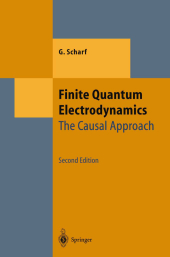 Neuerscheinungen 2012Stand: 2020-01-07 |
Schnellsuche
ISBN/Stichwort/Autor
|
Herderstraße 10
10625 Berlin
Tel.: 030 315 714 16
Fax 030 315 714 14
info@buchspektrum.de |

G. Scharf
Finite Quantum Electrodynamics
The Causal Approach
2nd ed. 2012. X, 410 S. 23,5 cm
Verlag/Jahr: SPRINGER, BERLIN 2012
ISBN: 3-642-63345-5 (3642633455)
Neue ISBN: 978-3-642-63345-4 (9783642633454)
Preis und Lieferzeit: Bitte klicken
In this textbook for graduate students in physics the author carefully analyses the role of causality in Q.E.D. This new approach avoids ultraviolet divergences, so that the detailed calculations of scattering processes and proofs can be carried out in a mathematically rigorous manner. Significant themes such as renormalizability, gauge invariance, unitarity, renormalization group, interacting fields and axial anomalies are discussed. The extension of the methods to non-abelian gauge theories is briefly described.
The book differs considerably from its first edition: Chap. 3 on Causal Perturbation Theory was completely rewritten and Chap. 4 on Properties of the S-Matrix and Chap. 5 on Other Electromagnetic Couplings are new.
0. Preliminaries.- 0.0 Historical Introduction.- 0.1 Minkowski Space and the Lorentz Group.- 0.2 Tensors in Minkowski Space.- 0.3 Some Topics of Scattering Theory.- 0.4 Problems.- 1. Relativistic Quantum Mechanics.- 1.1 Spinor Representations of the Lorentz Group.- 1.2 Invariant Field Equations.- 1.3 Algebraic Properties of the Dirac Equation.- 1.4 Discussion of the Free Dirac Equation.- 1.5 Gauge Invariance and Electromagnetic Fields.- 1.6 The Hydrogen Atom.- 1.7 Problems.- 2. Field Quantization.- 2.1 Second Quantization in Fock Space.- 2.2 Quantization of the Dirac Field.- 2.3 Discussion of the Commutation Functions.- 2.4 The Scattering Operator (S-Matrix) in Fock Space.- 2.5 Perturbation Theory.- 2.6 Electron Scattering.- 2.7 Pair Production.- 2.8 The Causal Phase of the S-Matrix.- 2.9 Non-Perturbative Construction of the Causal Phase.- 2.10 Vacuum Polarization.- 2.11 Quantization of the Radiation Field.- 2.12 Problems.- 3. Causal Perturbation Theory.- 3.1 The Method of Epstein and Glaser.- 3.2 Splitting of Causal Distributions.- 3.3 Application to QED.- 3.4 Electron Scattering (Moeller Scattering).- 3.5 Electron-Photon Scattering (Compton Scattering).- 3.6 Vacuum Polarization.- 3.7 Self-Energy.- 3.8 Vertex Function: Causal Distribution.- 3.9 Vertex Function: Retarded Distribution.- 3.10 Form Factors.- 3.11 Adiabatic Limit.- 3.12 Charged Particles in Perturbative QED.- 3.13 Charge Normalization.- 3.14 Problems.- 4. Properties of the S-Matrix.- 4.1 Vacuum Graphs.- 4.2 Operator Character of the S-Matrix.- 4.3 Normalizability of QED.- 4.4 Discrete Symmetries.- 4.5 Poincaré Covariance.- 4.6 Gauge Invariance and Ward Identities.- 4.7 Unitarity.- 4.8 Renormalization Group.- 4.9 Interacting Fields and Operator Products.- 4.10 Field Equations.- 4.11 Problems.- 5. Other Electromagnetic Couplings.- 5.1 Scalar QED: Basic Properties.- 5.2 Scalar QED: Gauge Invariance.- 5.3 Axial Anomalies.- 5.4 (2+1)-Dimensional QED: Vacuum Polarization.- 5.5 (2+1)-Dimensional QED: Mass Generation.- 5.6 Problems.- 6. Epilogue: Non-Abelian Gauge Theories.- Appendices.- A: The Hydrogen Atom According to the Schrödinger Equation.- B: Regularly Varying Functions.- C: Spence Functions.- D: Grassmann Test Functions.- Bibliographical Notes.


